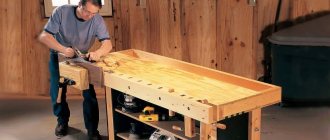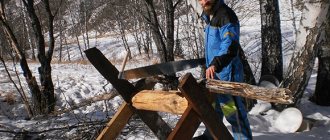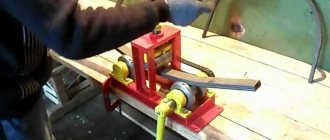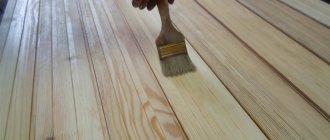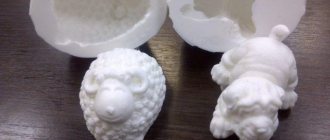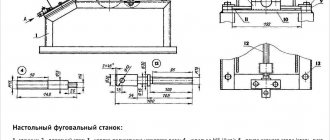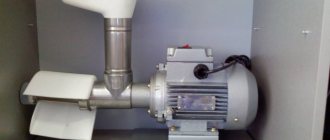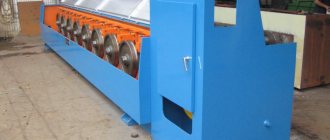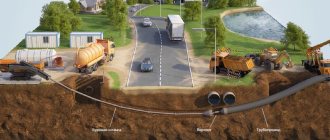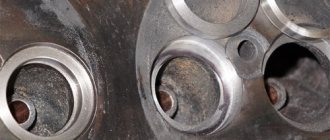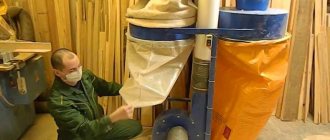Wooden lining is often used when finishing walls and ceilings. This material is comfortable and has an attractive appearance.
Another advantage of lining is that you can make the lining yourself. Of course, to do this you need to learn the production technology itself, as well as purchase some additional equipment. But after this, the production of lining can become an additional source of income for you.
So, in this article we will learn how to make lining with your own hands, what tools and materials are needed for this.
Manual device from an angle grinder
If you have a grinder on your farm, then you won’t find a better device for a hand-held circular saw. Don't know how to make a saw at home from such a popular tool? Don’t despair, because its manufacture only involves providing a sliding stop and an axial handle to an existing unit. The sliding stop includes in its design two pieces of metal corner of a small cross-section, located on both sides of the saw blade. Using bolts and nuts, the corners are connected from the front and back sides with a transverse ligament, and the technological gap between the sidewalls of the thrust structure and the working element will be provided with washers.
It is necessary to put a metal band clamp on the grinder so that its screw tie is located at the bottom, and a strip of galvanized metal with a hole for a sliding stop, folded in half, is fixed to it. In principle, a special clamp with a stand can be made as a single unit, but in this case the thickness of the metal strip will ideally be at least one and a half millimeters. Next, you will have to make a couple of holes for bolts in the gearbox housing of the future circular saw, for which it is disassembled and the drilling points are determined. Through the holes made, an axial handle for a circular saw assembled from a grinder is attached, since the existing handle will not allow for high-quality cuts, even if the master has remarkable physical strength.
The axial handle, which will be equipped with a grinder grinder, is made of a metal rod or tube. The shape of the design can be a transverse bracket or a kind of horn. The ends of the metal part with which the handle is attached to the gearbox are equipped with holes for fasteners. There is one important point here: the ends cannot be riveted in order to prevent the handle from bending during operation of the circular saw assembled with your own hands. It is also necessary to make an adjusting rod from a piece of metal rod (4 - 6 mm), for which we bend one end into a loop, rivet it a little and form a hole for the front stop bolt. As usual, we adjust the uniformity of the gap with washers.
At the other end of the rod, a thread is cut, thanks to which it is connected to the handle. First, one nut is screwed onto the thread, and after assembling the structure, a second one is screwed. By tightening and lowering the nuts of this device for a homemade hand-held circular saw, the depth of cut is adjusted. This is how, at home, you can convert an angle grinder into a full-fledged disk tool designed for cutting various materials. By the way, by remaking a circular saw from a drill, you can achieve a similar result.
Formation of sheathing
The lining is mounted on a pre-prepared sheathing made of wooden blocks and slats attached directly to the wall or ceiling, at a distance of about a meter from each other. Such elements are fastened in a perpendicular position relative to the planned position of the lining; both horizontal and vertical placement of boards is provided.
For uneven walls, a type of fastening is provided, where the sheathing is aligned plumb or level when done:
- attaching hangers to the wall surface, on which planks or bars are installed level;
- driving wedges made of plastic or wood between the sheathing elements and the wall, which is necessary to level the beam.
We suggest you read: Do-it-yourself brick stove repair
When the walls are smooth, the bars can be attached directly to the walls, without prior leveling, using:
- nails that are suitable for wooden surfaces;
- dowels or screws recommended for concrete and brick walls;
- glue, the use of which is intended for those cases where drilling and driving in cannot be used.
Using a hand router for carving
You can significantly simplify the process of wood carving with a hand router. This special electric machine allows you to perform almost all types of artistic carving much faster. The only exceptions are sculpted and notched carvings. A hand-held wood carving router is a specialized tool for wood processing. The main parts of the tool are cutters, heads with cutting parts of different shapes, each of which has its own purpose:
- profiling the edges of wooden parts;
- milling of decorative and technological grooves of various configurations;
- production of unusual parts;
- creation of artistic carved products using a hand milling machine.
Using a router, it is easy to make various elements of wood carving: wooden trim, carved plinths, carved cornices and a wide variety of moldings.
A hand milling machine can be used to produce exclusive custom-carved furniture with great efficiency. Artistic carving with a hand router is most often done with fillet and V-shaped cutters, which allow you to make engraving of the desired length. Disc types of cutters are designed for sawing rectangular grooves.
The size of the lining depending on the type of wood
The type of wood from which the lumber is made also affects the final profile size. The most popular varieties of trees from which molded products are made are larch, cedar, and Angara pine. The main parameters, grades and prices of lining in our company are presented in the table below
| Pine/spruce | larch | Linden | cedar | Angarsk pine | |
| thickness | From 12.5 mm to 13 mm | 14 mm | 14 mm | 14 mm | 14 mm |
| length | 6 meters | From 3 to 4 meters | From 1 to 3 meters | 2 to 3 meters | From 2.4 to 4 meters |
| Width | From 96 mm to 140 mm | From 96 mm to 140 mm | 96 mm | 140 mm | From 90 to 115 mm |
| Price | From 270 rubles per m2 | From 450 rubles per m2 | From 700 rubles per m2 | From 650 rubles per m2 | From 550 rubles per m2 |
Block house machine
One of the varieties of lining (by the way, in enormous demand) is a block house. The material imitates rounded logs and is widely used for external and internal decoration of premises. It makes sense to cover houses with a block house, because such lining has a solid appearance, is durable and environmentally friendly, as it is made of natural wood. The panels are characterized by a complex shape, so the elements are connected using the “groove-tenon” principle. Making them manually is difficult and is fraught with “inconsistency” of individual “logs” in the future, so it is advisable to use specialized equipment:
- band sawmill;
- drying chamber;
- lining manufacturing machine.
When processing workpieces on machines, you can perform a number of operations:
- cutting prepared raw materials to the required size;
- surface milling;
- formation of recesses (grooves and tenons).
Installation methods
There are the following methods of attaching the lining to the finished sheathing:
- Direct. Using nails or self-tapping screws directly to the slats or profile;
- Kleimernoe;
- Stapler.
Fastening eurolining to a frame using nails and self-tapping screws is popular due to its simplicity and the ability to do the work yourself without additional elements. The main secret of this installation method is that fasteners are inserted into the wood at a special angle, which ensures a strong and rigid connection between the panels and the installation base. It should be noted that this option is not suitable when working on a metal profile or if you need to hide the attachment points.
Photo - mounting plan
Photo - installation of clamps on the lining
The selection of brackets is carried out according to the thickness of the panels. There are various clamps, which are classified according to the height of the tongue - the indentation into which the lining sheet is installed. This hidden mount is ideal for installing paired lining in a bathhouse or living quarters.
Photo - types of fastening
The simplest of all the options described is to install the lining with a stapler. The technology is practically no different from the usual use of a stationery stapler: the device has a compartment for staples and a latch (flat pressure panel). If pressure is applied to the compartment with staples, the staple comes out from the compartment and is installed into the wood at an angle of 45 degrees.
Manufacturing eurolining on a milling machine
This is more complex work; you will need solid experience working with woodworking machines. We will tell you about the technology, and select the dimensions of the lining and the profiles of the front surfaces yourself, taking into account the availability of tools and personal preferences.
The design of the machine is quite complex. Complete instructions must be included with such equipment.
We see an example of a homemade machine for making lining, its components and details
We see another example of a homemade machine for the production of lining at home
How does eurolining differ from regular lining?
- The tongue/groove connection is deeper. Due to this, the risk of seams showing through during a significant reduction in the width of the boards is eliminated, and installation of the sheathing is simplified. It is easier to insert hardware for fastening into a deep groove.
- The reverse side has one or two slots - the wall surfaces can breathe, static forces are reduced when changing the linear dimensions of the lining. It is as a result of strong static forces that the cladding of a house can warp.
Photo - Eurolining category B
As the initial data, we assume that the boards of the required sizes have already been prepared, the material is sorted and folded in the proper place.
Step 1. Install a cutter on the machine to make a groove and a side decorative chamfer, adjust the depth. To do this, release the ruler, place the end of the board against the knife and, moving the ruler closer or further, find the desired position. Fasten the milling head and ruler with great force.
Mills used in the manufacture of lumber
In order to correctly align all the knives on the head, you need to plan a section of the board as a test. Next, place it again on the cutter and, slowly rotating the head in the opposite direction, check that all the knives are working. You can recognize this by the sound; if everything is normal, then the number of minor touches on the board should correspond to the number of cutters. For example, if the head has four knives, but you only felt three touches, then this means that one knife is not working. Find which one and adjust its position. This is quite difficult to do and will take several attempts. Make sure that the spacer wedges of the knives are pressed firmly against the head.
Knives
Several different knives-attachments for a homemade machine for making lining will allow you to create various wood products
Step 2. Attach the top and side clamps, set the desired distance. Such stops greatly facilitate the milling process, improve quality and increase labor safety. Pass all the boards on one side.
Step 3. Replace the cutter with a new one; it should cut the groove and remove the decorative chamfer. There is no need to re-adjust the clamps; the width of all boards is the same and did not change during the first pass.
Step 4. Remove the side cutter and release the ruler and clamps. Install a cutter to make recesses on the inside of the lining. The size and number of grooves do not matter; select them at your discretion.
Manufacturing eurolining on a milling machine
Industrial production technology
Lining - what kind of material is it?
You will need this knowledge in order to independently make the best decisions when making lining at home. The process of industrial production of lining consists of several stages.
- Making boards. The logs are sawn on band or disk sawmills into edged boards of specified parameters. The thickness of the board is in the range of 15-25 mm, width 100-150 mm. Specific dimensions depend on the type of lining.
- Drying lumber. The process takes place in chamber drying, which reduces the amount of waste and minimizes the risks of torsion and cracking of boards.
- Sorting. Lumber is sorted depending on quality. For the manufacture of lining, boards of at least second grade are selected.
- Manufacturing of lining. The process takes place on a powerful four-sided planer. By selecting various cutters and knives, four planes are processed in one pass, and the desired profile is immediately created on them.
Lining production line
- Quality control and product storage.
Warehousing of linings
That’s all the technology is, there is nothing complicated, modern equipment allows you to automate production to the maximum. It is impossible to achieve this at home; you will have to waste much more time making the forcing.
Table. Classes of lining and their description.
| Class or variety | Description |
Extra | Free from cracks, knots and other defects. The surface is perfectly smooth and even. |
A or 1 | The surface is smooth or slightly rough. There is 1 healthy knot per 1 linear meter (knot diameter no more than 1.5 cm). There may be cracks: hairline cracks - no more than ½ of the panel in length, non-through cracks - less than 9.5 cm in length (the exit of the cracks is directed towards the end of the panel), which appeared during drying - no more than the width of the panel. There may be tars and resin pockets of 2 pcs. at 1 m p. |
B or 2 | There are many knots, of which no more than 2 can fall out. per 1 m p. There may be through cracks up to 1 mm wide and up to 15-30 cm long, hairline cracks are allowed along the entire length of the board. The presence of wormholes (3 pieces per 1 square meter) and rot (no more than 1/10 of the panel) is allowed. Grade B lining is suitable for painting. |
C or 3 | The quality is low. Many different defects. This lining is suitable for upholstery of technical rooms or rough work. |
Classification of lining
Prices for lining
Lining
Stages of lining production
The process itself begins with drawing straight lines along which the sides of the boards will be sawn in the future. It is recommended to use green or blue pencils, this is necessary so that the lines are clearly visible in case the wood is damp and begins to turn blue. To cut the board, place it on the table top of the machine so that the previously marked lines are straight.
To cut the other side of the board, the machine must be reconfigured. To do this, set the ruler to the required width. It is common practice to use two clamps for fixation during processing. Then the second side of the board is sawed according to the adjusted ruler; when cutting the side without using a ruler, the output will appear sawn under the ruler. Put them in a separate place, we will need them for slats.
For those who are interested in how to determine the width of the slats, the answer is simple; for this, sawn-off lining is installed, which will be used instead of a ruler.
Now let's move on to the production itself. It’s worth noting right away that the process of making lining with your own hands is quite painstaking work. In order for everything to work out correctly and subsequently make you (or your customers) happy, you need to be patient. Otherwise, the finished products will turn out to be of different thicknesses and widths, which means that the appearance of the surface finished with clapboard will be spoiled.
The process of making lining with your own hands will consist of the following stages:
- First of all, we cut the boards into pieces of the required length;
- Next, the workpieces need to be sawn lengthwise to make planks of the required width;
- the next step will be jointing;
- Finally, we make grooves.
To complete the second stage, draw a straight line on the workpiece from one edge. To do this, it is better to use a blue or green pencil; it will be better visible on the surface. Next, using a circular saw, saw off one edge. It is better to process more boards in this way at once, so all the work will be completed faster.
The following steps will require your attention. It is necessary to rearrange the saw along the ruler so that the second cut accurately measures the width we need. After setting up the machine, we begin sawing off the second side of the future lining.
Next, let's start jointing. This process will give the workpiece a smooth surface, and will also make all products the same thickness. To ensure this happens, remember how many times you passed each side through the jointer. Then process all other workpieces the same number of times.
Milling lining grooves
For such work, it is advisable to have a universal woodworking machine. This device is equipped with all the necessary equipment for processing wooden workpieces. As a rule, such a machine is equipped with a jointing device and a circular saw. At the same time, it has a work surface convenient for processing wood. With such a machine, making lining with your own hands will not be difficult.
From the video you will learn how to make and use special clamps for more efficient milling of lining grooves.
While working, you should take advantage of some tips and recommendations from experts:
- First of all, you need to work correctly with the woodworking machine itself. When cutting blanks for lining lengthwise, it is necessary to lay the board on the work surface. Further, its movement towards the circular saw is carried out using the body. It is with them, and not with your hands, that you need to push the workpiece. In this case, the risk of injury is significantly reduced;
- so that the lining turns out to be the same width, when reinstalling the saw to cut the second side of the workpiece, you can use the finished product as a ruler;
- After all the work is done, you will be left with a lot of wood waste. You shouldn't get rid of them right away. When cutting blanks, you get a lot of thin planks; they can be used as slats to create sheathing. In this case, you will be able to save significantly on material.
After all the manipulations, you will have a finished, beautiful and practical lining. All that remains is to treat it with impregnations, and you can begin installation. Treatment with an antiseptic should be carried out on all sides, and not just on the front, this will preserve the strength of the material for a long time.
List of the minimum set of tools and equipment
First of all, you must have a special separate room for work; woodworking machines create a lot of noise and dust. You will have to comply with the requirements of sanitary authorities. Another condition is that the electrical wiring must withstand additional loads, and they, depending on the brand of machines and their number, can increase significantly.
On a note! You can make both the simplest and quite complex lining with your own hands; we will consider both manufacturing options. But for all options there are several preconditions.
Making lining with your own hands
What determines the quality of homemade lining
Homemade lining
At home, all cutting parameters must be observed independently and quickly changed depending on the characteristics of the board and the capabilities of the machine. What should you keep in mind?
Pay attention to the location of the grain; never process lumber against the grain. Monitor the condition of the bearings
The slightest beating will certainly affect the roughness of the surfaces. As soon as it is discovered that the machine shaft is a little wobbly, the bearing must be urgently changed or, if possible, adjusted. Tenths of a millimeter of vibration significantly degrade the final quality. The serviceability of cutting tools is one of the important components of surface cleanliness. Saws and cutters must be sharp. If you make cutters yourself, then use only durable grades of tool steel. The geometry of all cutters must be the same. Otherwise, some of them will not work, and this is a very undesirable phenomenon. Position the cutters accurately, do not rush. It is very difficult for an inexperienced master to set all the cutters at once, do not be discouraged. Lose more time, but achieve the desired result. The lost time will be more than repaid in the future.
The cutters form the tenon and groove, and also determine the geometry of the lining
The more cutters, the better. If the head allows you to install four, then do so, do not work with two. Four cutters slightly increase the installation time, but then the machine works longer – they become less dull.
Set of cutters
Always use exactly the same wedges to secure the knives. Even small differences in mass cause head vibration. Vibration not only degrades the quality of processing, but also causes rapid wear of bearings and increases the risk of injury. Observe cutting conditions for lumber
We can talk about this topic for a very long time; cutting modes have a huge number of options. Beginning craftsmen need to become at least a little familiar with the theory, and in the future everything depends on the ability to learn practically and the desire to work with woodworking machines. Before feeding the board to the machine, inspect it, select the optimal cutting direction, taking into account the characteristics of the surfaces, the presence and type of knots and other defects. Place the finished lining in even stacks, do not place it vertically, and do not scatter it throughout the workshop. Cleanliness and order are evidence of the professionalism of the master.
The lining is folded in even stacks
If you have little experience, then the input/output of the board may be defective due to a slight change in the direction of movement and non-parallelism with the ruler. Keep this in mind when determining the length of the lining, make a reserve in length.
Options for the location of the lining on the plane of the wall and ceiling
The lining on the plane of the wall (ceiling) can be positioned vertically or horizontally. Traditionally, Euro profile lining is located vertically, and Calm profile lining is horizontal. This is primarily due to the peculiarities of perception of horizontal and vertical lines. Vertical lines, especially emphasized by a wide strip of shadow from window light, due to the difference in the surface of the lining profile on the wall, visually increase the space between the floor and ceiling.
Disadvantages: visibility of fasteners; when installed outdoors, streaks of zinc appear when exposed to precipitation; fastening is only in the tenon area. Pros: high reliability, high speed of installation, low cost of operation.
The procedure for installing the lining using the open method does not require explanation and can be carried out either “tenon-to-groove” or “groove-to-tenon” with the subsequent fastening of each lining through its front surface to the sheathing. The open method of installing lining is used, as a rule, when it is oriented horizontally with the tenon facing up and the order of work is performed from bottom to top.
For Euro lining, this fastening method is standard. Disadvantages - requires a qualified installer and knowledge of the operating characteristics of wood, only one direction of installation - “tenon in groove”, pros - the absence of a visible attachment point on the front surface.
This installation method is most convenient when the lining is in a vertical position; the clamp is inserted into the groove, installation is carried out “tenon in groove”. Indoors only!!!! Horizontal installation of eurolining on clamps is possible with its tongue-down orientation. Outdoor horizontal installation of lining with the tenon down is unacceptable.
This method is used for the “calm” profile and is due to the ability to hide the attachment point at the junction of the linings. Pros - high installation speed, reliability comparable to the open fastening method, convenient installation when the lining is in a horizontal position with the tenon facing up.
Hidden installation of the “calm” lining is carried out in the “groove to tenon” direction. The length of the screw must be selected based on the thickness of the lining and the thickness of the base. The most typical version of the self-tapping screw from our range is for interior decoration 3.0*30mm and 3.5*35mm
When finishing any surface, you can use three mounting options - horizontal and vertical laying, as well as at an angle of 45°. How to attach the lining depends on the taste and desire of the home owner. The sequence of the cladding does not depend on the chosen option, but when attaching panels “from bottom to top”, the last row may have to be adjusted in width.
We invite you to read: How to build a sauna with your own hands from blocks
For high-quality installation of the lining, do not hammer nails into the wood or tighten screws without a pre-drilled hole of the appropriate diameter. Without a prepared hole, the lining may crack; when driving a nail or tightening a screw, you can damage a lot of the original and, very importantly, expensive material.
Another professional trick. Having brought the lining from the store, do not immediately start installing it. Open the packaging of the lining and give the wood panels a few days to gain ambient humidity - this will reduce the risk of deformation of the material after fastening. And the walls, balcony ceiling and lining guides should be treated with any antiseptic.
Installation of lining using clamps
1. Installation using clamps is the most convenient method. The clamps are attached to the sheathing with nails or self-tapping screws. To secure the lining, the clamp is placed against the wall, the board is set in place and nailed to the sheathing through the hole.
2. Installation using nails and screws is carried out through a drilled hole. This method is more suitable when covering a wall with clapboard “from top to bottom”. The bottom row of panels is attached through holes that are hidden from view by the plinth.
3. Using through holes in the body of the wood. The heads of nails or screws must be recessed, or even better, covered with decorative inserts.
Nails are driven into the sheathing to a partial length and the heads are cut off with wire cutters. Then the panel is carefully hammered onto the protruding nails with a mallet. With a little practice, the installation results in a very neat installation. For strength, you can strengthen the panels with small nails in two or three places. To give the decoration of a balcony or loggia decorative properties, it is necessary to treat the panels with paint or varnish.
Characteristics and power
The functionality of using the equipment will depend on the correct choice of parameters, including speed indicators and drive power. The power rating is affected by the maximum permissible diameter of the toothed saw. It is believed that to process lumber with a thickness of about 10 millimeters, an electric motor with a power of 1 kW will be required. Based on the thickness of the processed and sawn timber, you should select the power of the electric motor.
Transmission from the drive in a self-made circular machine is best done using a V-belt. This allows you to ensure the necessary safety of using the equipment. When foreign objects get under the saw, the V-belt drive will slip on the pulleys, which eliminates injuries and jamming of the working disk.
Tips and recommendations for choosing the size of the lining
To choose the optimal size and type of lining, first of all you need to know exactly the parameters of the room (length, width, height) where the finishing will be carried out. If we are talking about the facade of a building, it is also necessary to take into account the parameters of the roof. If we multiply the width and height of the space to be finished, we get the number of square meters. This formula is convenient to use if the space requiring finishing has the correct shape.
If the room has an irregular or complex shape, it is necessary to separately calculate the parameters of individual sections and then summarize the obtained indicators.
In order to calculate the required amount of lining, you need to multiply the parameters of the room by the parameters of the thickness of the lining. And if you want to find out how many panels are in one cube, you need to multiply the length, width and thickness of the selected lumber. It is advisable to increase the resulting result by 15% in case of an unforeseen situation that may arise during the finishing process.
If such mathematical calculations make it difficult for you, then the easiest way is to contact representatives of the company where you are going to purchase the lining. Also, as a rule, the website of profiling organizations has an online calculator function that allows you to determine the preliminary order amount.
Types of wood cutters
In most cases, not all cutters will be needed, but only slotted ones. But others can also be useful for applying decorative notches. When purchasing a wood cutter for making lining, you need to consider the diameter of the shank. To do this, you should find out what collets are equipped with your existing manual router or machine. The most common cutters with shank diameters are 6.8 and 12 mm.
Inch cutters and regular cutters (with shanks measured in mm) are not interchangeable. That is, they cannot be inserted into a “millimeter” collet, although it seems that the difference is only tenths of a millimeter.
According to the design features of the cutters there are:
- Monolithic - cutting edges and shank are one piece. This is the cheapest and most common type. When the working edges become dull, the cutters are thrown away.
- With replaceable cutting edges, the double-sided knives are removable and can be flipped to the other side.
- Prefabricated - cutting elements are welded (soldered) to the main rod.
- For soft woods, high-speed alloys are used, designated by the letters HM.
- If the surface being treated is hard, then carbide steels - HSS - are used.
- Slotted straight cutters - with their help you can get a rectangular groove; the working part of the cutter itself has the form of a cylinder with cutting lower edges.
- Grooved fillets are similar to straight grooved ones with a rounded working edge, resulting in the shape of the groove in the form of the letter “U”.
- Groove fillet V-shaped - the tool is used to produce various V-shaped grooves; they differ in the size of the groove and the size of the angles.
- Groove structural - after milling, the groove has the shape of the letter “T”, turned upside down. Or “dovetail” - a groove in the form of an isosceles trapezoid that tapers towards the top.
- Groove shaped - needed for creating figured carvings, working with edges; the groove resembles a funnel and other symmetrical elements.
- Edge machines - differ in that they are designed for processing ends and edges; often the design includes a bearing for working according to a template.
- Edge straight lines - needed to obtain a right angle between the upper plane of the workpiece and the end part.
- Edge molding - to obtain a semicircular edge in the form of a wave, and of different shapes (depending on which part of the cutting plane is used), double cutters may have adjustment of the gaps between the cutter blades.
- Seam edges - allow you to choose a rectangular groove, a quarter on a flat or curved workpiece. The processing depth is adjusted using the position of the router or the diameter of the thrust bearing.
- Edge conical - needed for creating various kinds of decorative chamfers, for working with edges before joining them with other products, and so on.
- Edge fillets - with their help, semicircular grooves are obtained. To ensure that there are no distortions during operation, 2 bearings are provided in the design of the tool.
- Curved edge cutters (multi-profile) - to create complex-profile side edges, the length of such cutters is longer than conventional cutters; a powerful cutter is required for normal operation.
- Edge semi-rod - needed to obtain a semicircular protrusion at the end.
- Combination cutters are used to create tenon joints between several boards, both for corner and panel structures.
Most of all, the work will require tongue-and-groove cutters for lining. It is with the help of this tool that a tongue-and-groove system is created to connect the panels during assembly. They come in a set of two pieces. And for work you no longer have to calculate the dimensions of the groove and tenon.
There are varieties of tongue-and-groove regular paired cutters and those that are designed specifically for creating lining panels. The latter are distinguished by the fact that they allow you to simultaneously grind a groove/lock and round the edges on the front side. Using ordinary cutters, you can make flat panels from boards, for example, for a garage, where decorative chamfers are not needed.
Combined frame sets are kits; the blades can be positioned on the main axis, depending on what kind of work is supposed to be done. They contain: one or more thrust bearings, a lock washer and a clamping nut.
Figurine - needed for decorative processing of edges when creating panels. Since there is a bearing, both straight and semicircular surfaces can be processed. The diameter of the working edge of such tools is quite large, so powerful electrical equipment is needed to operate.
Processing and protection
This is the final stage of lining installation, which involves covering the installed material with additional layers of a protective or decorative composition. At this stage (beginning of installation activities), initial antiseptic treatment can also be carried out if it was missed at the preparatory stage.
- Varnish compositions help preserve the original color and texture of wood over a long period of time.
- Thanks to the stain, the required color scheme of the cladding material is achieved; the number of layers of this composition can change the shade of color.
- Impregnation with wax gives the material a certain shine. After its use, the lining can be treated with paints and varnishes.
- Glaze with a UV filter is transparent, due to which the original texture of the wood is preserved and transmitted, and the wax and oil contained in its composition preserve the natural breathable properties of the material.
Tags: lining, installation, hand, your own, calm
« Previous entry
How to make a grinder at home
If we describe the design of the grinder quite simply, then it is a motor, 2-4 rotating rollers, one of which is adjustable, and a sanding belt. A grinder is usually distinguished from a manual grinder by a fixing stand with the ability to change the angle of inclination.
The stand is necessary for precision work. We decided to make descents - fix it, set the desired angle of inclination of the stand and start the grinder.
As for the adjustable roller, it is a must. After all, the sanding belt stretches over time, and subsidence forms. The roller is pulled up and the work continues. There is another important point: sanding tape is suitable only on an elastic basis. Otherwise, it will break under the load.
To assemble the machine at home, you will need:
- Think over the design of the device and make drawings.
- Prepare all the necessary tools: jigsaw, drill, ShMU.
- Prepare the parts required during the assembly process or arrange with a turner for turning them.
First you need to decide on the tape, or rather its length. For domestic use, the optimal option is 915 mm; this is the length with which the majority of Chapaevsky machines work.
The base for the bed must be more than 12 mm thick. Bolted connections in this situation are unreliable. It is advisable to use welding.
When turning rollers, the roughness index is important, which should be at least 1.25. Otherwise the tape will wear out quickly
If the machine is planned to be made with four rollers, then it is customary to use the following dimensions: 150 mm for the leading one, 100 mm for the adjustable one, and 70 mm for the remaining one. It is important to position them without distortions to avoid the tape slipping
The cost of a finished pulley starts from 2000 rubles. Somewhat cheaper you can order from private turners.
Grinder made by yourself.
Particular attention should be paid to the drive for the grinder. If it is not possible to acquire a specialized engine, you can use an alternative
It is advisable to use an engine with a power of 0.75 kW or higher, and a speed of 1,200 or more.
Homemade grinder with a washing machine engine
With a drive pulley size of 70÷100 mm, the motor for the grinder must spin up to at least 3000 rpm. The motor, removed from an old automatic washing machine, has low power (below 300 W). It is characterized by good reliability and is unpretentious in operation.
The popularity of using just such a drive is due to its wide distribution.
The drive from the washing machine must be included in the preliminary drawing. A do-it-yourself grinder at home requires a motor with an output shaft. In this case, the shaft has a threaded connection, the design of which allows it to be connected to the pulley without much difficulty.
From a drill
A grinder for a drill is a special attachment that can be made in several stages. There are hundreds of different manufacturing options. Let's consider one of the simplest and most reliable, step-by-step instructions:
- Everything necessary for work is prepared: shaft with gears, bearings and sheet metal.
- Two plates measuring 110x250 mm are cut out.
- The necessary holes are drilled on each of the plates. In this part the bearings will be fed for adjustment.
- Next, take a “hairpin” and cut it into 120 mm pieces. Homemade rollers are installed on studs and secured with bolts. The tape is stretched and fixed on the other side.
- A base is made for attaching the grinder. The machine is mounted on the bed, and the drill is fixed with clamps.
- A corner is sharpened and attached for convenient fixation of the knife during sharpening.
From the Bulgarian
The main design difference between an angle grinder and other types of power tools is that its output shaft is turned at an angle of 90º to the axis of the electric motor and, accordingly, to the housing. For this reason, it is called an angle grinder.
This feature is perfect for longitudinal fastening of the drive roller and the “electric file” blade. The result is a tool that is elongated in a line and very comfortable to use. The same attachment for a drill is located at a right angle to the body, which is quite inconvenient for work.
To make a device, it is enough to make a metal base for the rollers, tension the tape, and adjust the dimensions of the drive roller to the ShMU guide, and the machine is ready.
Main profile parameters according to GOST
The main parameters of the lining are regulated by GOST standards for profile parts made of wood for construction and for softwood lumber. As for the profile length, there are no strict regulations. As a rule, lining from 2 to 6 meters goes on sale. There are also no special requirements for the profile width; this parameter varies from 13 to 120 mm. Buyers, as a rule, prefer to purchase the type of profile that is convenient to transport.
The width and length of the profile are taken as a guide when it is necessary to determine the volume of products purchased. Regardless of the parameters of the lining, the installation principle of the product is identical, which is very convenient for the buyer. If repair or dismantling work is necessary, it will be very easy to find a similar profile of the required size.
On the product packaging, as a rule, the parameters are indicated in the following order: grade, thickness, width, length. The characteristics of the profile values largely depend on the type of wood from which it is made. It should also be taken into account that Russian standards do not correspond to European ones.
Necessary equipment
First you need to select and prepare a large and powerful machine for work. A practical purchase would be a second machine. Due to the fact that even the most powerful machine will begin to overheat after a certain period of time, giving it the opportunity to rest and cool down will be a mandatory working moment. The required characteristic of the machine is a power of at least one kilowatt. It is required to perform two main functions - cutting and jointing, that is, leveling the wooden surface.
When giving preference to any model, pay attention to the presence of play - a gap in places where parts are adjusted. A high-quality woodworking machine, for example, an American one, does not exceed a width of fifteen to twenty centimeters
But the rulers and cooling system must also be of high quality.
Aluminum tends to leave black marks on wood. There is a possibility of applying stripes to the finished product with a jigsaw. As a result, defects adversely affect the appearance of the material after processing, and the finished lining must be painted when it was possible to get by with colorless varnish. For the operation of the saw, a specialized casing is designed, which is put on the base of the saw in order not to stain the wood, when both the table and the ruler do not have protective devices.
You can make alder lining manually, for example, with a milling cutter or using a circular saw. The milling method is of better quality.
We invite you to familiarize yourself with our range of materials
Larch lining - Extra grade
Wood Larch Width 96 mm Thickness 14 mm Length 3 m Qty.
in pack 4 things. 1850 rub/m2Larch lining - Prima grade
Wood Larch Width 96 mm Thickness 14 mm Length 3 m Qty.
in pack 4 things. 1500 rub/m2
Peculiarities
Before we begin describing the manufacturing process, it is necessary to understand what this product is.
Lining is a type of facing material that is a product of processing natural wood. It is used to design both simple (linear) and complex structures. Depending on the technical characteristics, the products are used for exterior or interior decoration. Externally, these are flat panels with special connections at the edges.
In the production of lining, various types of wood are used, both deciduous and coniferous: alder, cedar, ash, pine, beech and much more.
Wooden finishing combines excellent performance and aesthetic qualities. Due to these characteristics, finishing has become widespread. Lining is used for external and internal cladding.
Advantages of lining:
- aesthetic appearance;
- a wide range of products, differing in color, texture and performance characteristics;
- it is an environmentally friendly product, safe for health and the environment;
- high-quality material has excellent practicality and wear resistance;
- finishing material made of wood is a classic that is always relevant and in demand;
- simple installation process;
- natural finishes create a comfortable atmosphere in the room.
Flaws:
- high price;
- requires careful care.
This is interesting: Features of polyurethane sealants for external seams: let’s look at them from all sides
Types of finishes
Swiss chalet
This design style is best used in a suburban area with a home of any size. We will need a wide lining 6 meters long to decorate the roof. A sloping roof with large angles of inclination and a visor is the central part of the exterior. This element not only creates the feeling of a house in the Alps, but also serves to protect the room from negative environmental factors.
Traditionally, a Swiss chalet has 2 floors with a balcony, or it can be a one-story building with an open terrace.
Inside the house, the interior is also made using lining of various lengths. The walls and ceiling are sheathed using lumber.
Provence One of the most popular interior styles, used both in private homes and city apartments. Coffee shops and small restaurants often prefer this design. The use of living textured material - lining in large quantities - is the basic principle of constructing the Provence style. Lumber, as a rule, is painted in light pastel shades - olive, pale pink, soft lilac. Lightness, a feeling of comfort and homeliness, the absence of unnecessary decor and furniture - true Provence style.
Country This type of design direction is most often used for one space in a living room: living room, kitchen or bedroom. The main goal is to create a rustic, sophisticated style.
Simplicity, but with moderate gloss, comfortable furniture, but without modern trends, and necessarily finishing the walls with high-quality lining (it is advisable to use the highest grades and lumber from expensive tree species).
The interior styles given as examples are far from the only ones. With the help of lining of various lengths, you can make your dream of comfortable, cozy housing come true for any financial opportunity.
Do-it-yourself lining on a circular saw
Wooden lining is a thin facing board with special cutouts that ensure ease of installation, which is in consistently high demand on the market.
This is a universal material, with its help you can create an elegant interior or cladding an external wall. The wood is completely harmless, the lining is suitable even for a children's room. Planks of any shape can be bought at a hardware store, or you can make them yourself; for this you will need a machine for making lining, material and, of course, desire.
Production of the required quantity of blanks
If you have a ready-made board (unedged), then it will have to be trimmed. At the same time, we make sure that the width of all the resulting blanks for the lining is the same. This is done like this: one side of the board is “beaten” in the old way. Namely: you have to smear a strong cord with charcoal (you can use a piece of a burnt tree branch) and press the cord to the board so that it is entirely on the plane of the board. We lift the middle part of the lace above the board and release it: the tension force will do its job - you will get a perfectly straight line on the board. Now let's make the necessary markings. To do this, we will retreat the same distance from the resulting line at different ends of the board (from 10 to 15 cm) and according to those received on the board. The board will have to be cut along these lines and the workpiece will be considered ready.
Choosing the right tree
The choice of material for the manufacture of lining cannot be considered only an accompanying procedure. It is at this stage that the quality of the future product is laid down. And the main thing when choosing is not to make a mistake with wood. Aspen, for example, is very easy to process, but it is a completely bad material in terms of finishing: it quickly loses its appearance, it warps from temperature changes and changes in humidity.
The best lumber can be considered from the coniferous family.
And the structure of the wood is very pleasant to look at, and it is not very difficult to process, and the service life of such wood is very long, especially if it is well impregnated. You should only be wary of tree trunks that have a large number of cuts from old branches. Young branches, as a rule, do not pose a danger to the material. But in the place of old branches, when planing, the core of the branch often falls out, which goes deep into the tree trunk.
